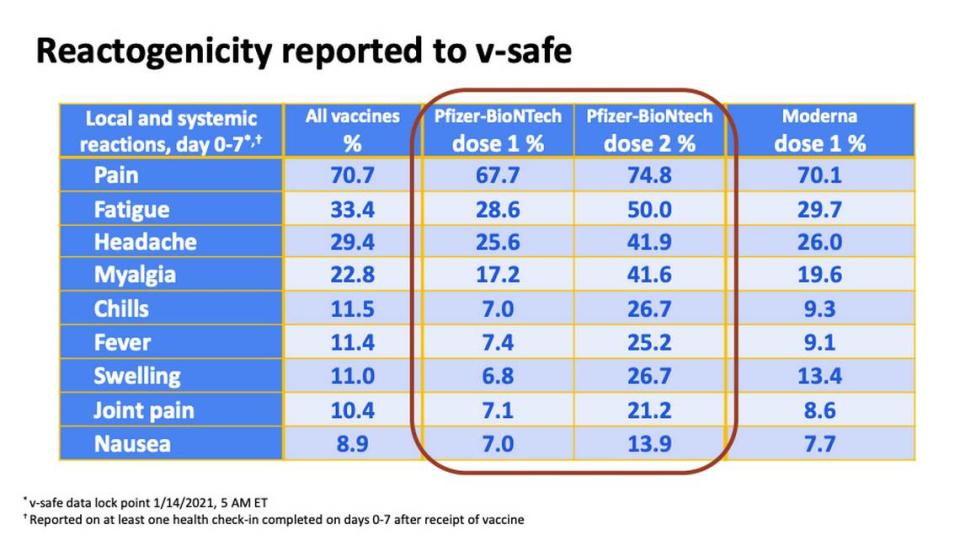Side effects after your second dose of COVID vaccine may be more intense. Here’s why
More than 27.1 million Americans have been poked with a coronavirus vaccine so far, with 6.4 million of them having received their second and final dose.
Like most regularly recommended vaccines, the two authorized for COVID-19 produce their fair share of expected side effects. Most people report fevers, headaches, fatigue, muscle aches and soreness around injection sites.
For many, the side effects are more powerful after the second dose is administered.
Health experts say these side effects are just normal signs your body is building the immune response it needs to protect you from severe disease. But these signs tend to grab more of your attention after the second shot — kind of like a roadside billboard that’s been revamped with flashing neon lights.
The first shot floods your immune system with instructions that teach your cells to pump out harmless proteins similar to those the coronavirus uses to infect people. Meanwhile, special cells in your immune system recognize the proteins as foreign invaders and send signals to other immune cells to fight them off.
The end result is an army of antibodies that are primed to spot and kill real coronavirus proteins if your body ever encounters them.
The second dose, which repeats this process, is a firm reminder of the threat of infection.
Not only does the threat make the immune system work even harder to nail the fight down, but it also solidifies maximum protection against COVID-19, a feat one dose can’t do alone.
“[The immune system is] asking, ‘Why is this happening 21 or 28 days later? I thought we took care of this four weeks ago,’” Dr. Mark Slifka, a vaccine expert and an immunologist at Oregon Health and Science University, told The Atlantic.
Will COVID vaccines need a booster shot to combat variants? Here’s what to know
Users of V-safe — a smartphone-based tool that you can use to report side effects to the Centers for Disease Control and Prevention after getting a COVID-19 vaccine — have reported stronger side effects within a week of getting their second jab compared to their first.
Reports of muscle aches and fatigue jumped the highest following second doses with the Pfizer-BioNTech vaccine, from about 17% to about 42% and from about 29% to about 50%, respectively. All other post-shot reactions such as pain, headache, chills, fever, swelling, joint pain and nausea spiked as well.

White House coronavirus adviser Dr. Anthony Fauci told reporters in January that his second shot “knocked” him out for about 24 hours, according to The Hill. “Fatigued. A little achy. You know. Chilly. Not sick,” he said.
“It’s normal,” Dr. Emily Landon, an epidemiologist at the University of Chicago Medical Center, told the Chicago Tribune. “Their immune system is doing a lot more work the second time… That’s where the memory kind of sticks.”
Although side effects may be uncomfortable, health officials say they should go away in a few days. After all, they’re just confirming your body is responding as it should.
“[It] means you had such a good immune response to the first dose and now you are seeing the effects of that,” Dr. Drew Weissman, an immunologist at the University of Pennsylvania, told Science in November.
And don’t worry if you miss out on the joy that is cold sweats and achy bones, experts say. No immune system is like the other, so some people may not experience side effects at all, even though their bodies are working just as hard.

